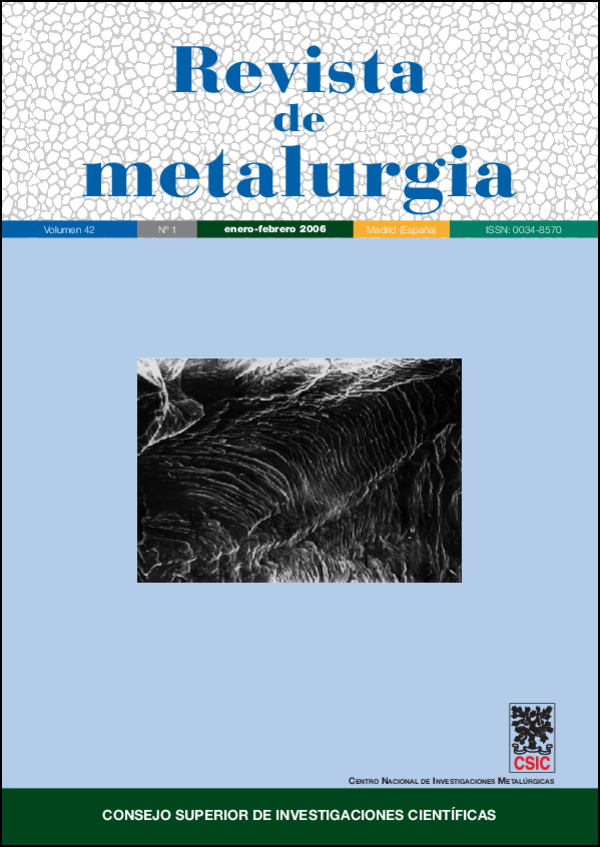Hot ductility and fracture mechanisms of a structural steel
DOI:
https://doi.org/10.3989/revmetalm.2006.v42.i1.2Keywords:
Continuous casting, Hot ductility, Fracture mechanisms, Transverse cracking, Structural steelAbstract
The hot ductility of a structural steel produced from scrap recycling has been studied to determine the origin of the transverse cracks in the corners that appeared in some billets. Samples extracted both from a billet with transverse cracks and from a billet with no external damage were tested. To evaluate the influence of residual elements and inclusions, the steel was compared to another one impurity free. Reduction in area of the samples tensile tested to the fracture was taken as a measure of the hot ductility The tests were carried out at temperatures ranging from 1000ºC to 650ºC and at a strain rate of 1·10- 3 s-1. The fracture surfaces of the tested samples were observed by scanning electron microscopy in order to determine the embrittling mechanisms that could be acting. The steel with residuals and impurities exhibited lower ductility values for a wider temperature range than the clean steel. The embrittling mechanisms also changed as compared to the impurity free steel.
Downloads
References
[1] B. Mintz, S. Yue Y J. J. Jonas, Int. Mater. Rev. 36 (1991) 187-217.
[2] J. Calvo, O. España, J. M. Cabrera, J. M. Prado Y R. D. Morales, XX Encuentro del grupo español de fractura, Número 20, Benicàssim, 2003, pp. 267-272.
[3] B. Mintz, Mater. Sci. Technol. 12 (1996)132-138.
[4] D. N. Crowther Y B. Mintz, Mater. Sci. Technol. 2 (1986) 671-676.
[5] R. Abushosha, S. Ayyad Y B. Mintz, Mater. Sci. and Technol. 14 (1998) 227-235.
[6] K. W. Andrews, J. Iron Steel Inst. 203 (1965) 721- 727.
[7] C. M. Sellars Y W. J. Mcg. Tegart, Int. Metal. Rev. 12 (1972) 1-24. doi:10.1103/PhysRev.12.1
[8] B. Mintz Y J. J. Jonas, Mater. Sci. Technol. 10 (1994) 721-727.
[9] B. Mintz, ISIJ Int. 39 (1999) 833-855. doi:10.2355/isijinternational.39.833
[10] B. Mintz, R. Abushosha, O. Comineli Y M. A. Loyola De Oliveira, Thermec’97, Vol. I, 1997, pp. 867-873.
[11] W. T. Nachtrab Y Y. T. Chou, Metal. Trans. A 17 (1986) 1995-2006. doi:10.1007/BF02644997
[12] B. Mintz, R. Abushosha Y J. J. JONAS, ISIJ Int. 32 (1992) 241-249. doi:10.2355/isijinternational.32.241
[13] J. K. Brimacombe, Metal. Mater. Trans. B 30 (1999) 553-566. doi:10.1007/s11663-999-0016-7
[14] B. Mintz, A. Cowley Y R. Abushosha, Mater. Sci. Technol. 16 (2000) 1-5. doi:10.1179/026708300773002591
[15] W. T. Lankford, Metal. Trans. 3 (1972) 1.331- 1.357.
Downloads
Published
How to Cite
Issue
Section
License
Copyright (c) 2006 Consejo Superior de Investigaciones Científicas (CSIC)

This work is licensed under a Creative Commons Attribution 4.0 International License.
© CSIC. Manuscripts published in both the printed and online versions of this Journal are the property of Consejo Superior de Investigaciones Científicas, and quoting this source is a requirement for any partial or full reproduction.
All contents of this electronic edition, except where otherwise noted, are distributed under a “Creative Commons Attribution 4.0 International” (CC BY 4.0) License. You may read the basic information and the legal text of the license. The indication of the CC BY 4.0 License must be expressly stated in this way when necessary.
Self-archiving in repositories, personal webpages or similar, of any version other than the published by the Editor, is not allowed.
















